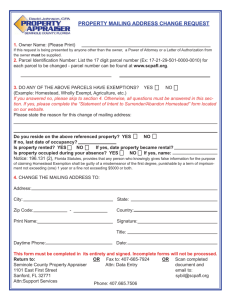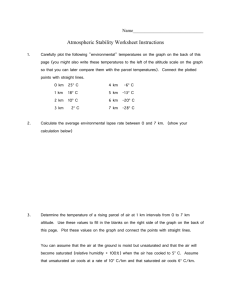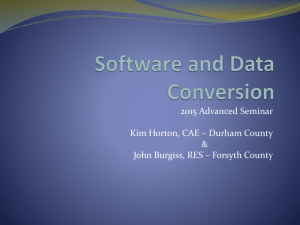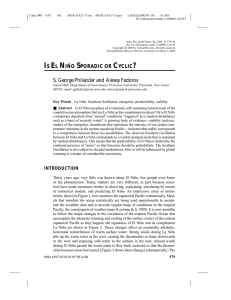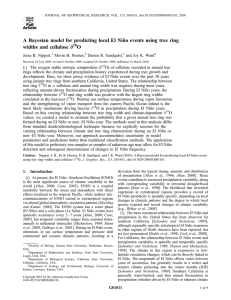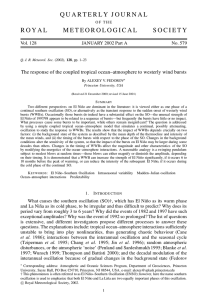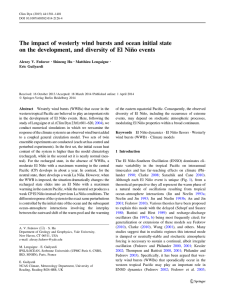21111 Prof. Seiberling PHYSICS DEPARTMENT MET 1010
advertisement
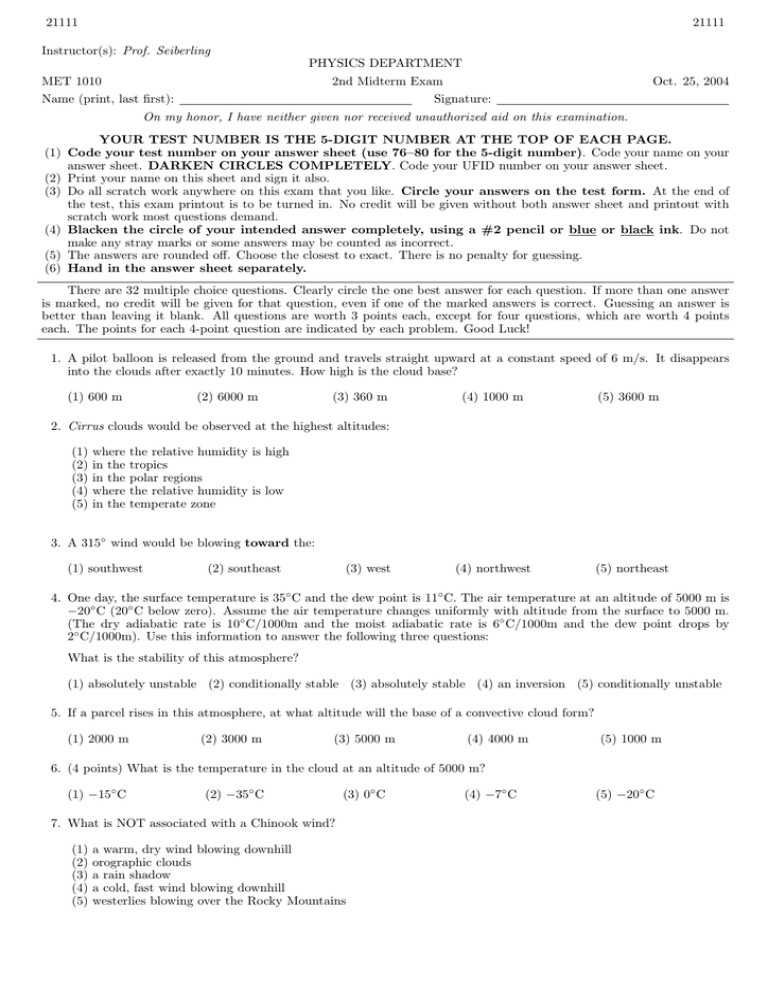
21111 21111 Instructor(s): Prof. Seiberling PHYSICS DEPARTMENT MET 1010 2nd Midterm Exam Name (print, last first): Oct. 25, 2004 Signature: On my honor, I have neither given nor received unauthorized aid on this examination. YOUR TEST NUMBER IS THE 5-DIGIT NUMBER AT THE TOP OF EACH PAGE. (1) Code your test number on your answer sheet (use 76–80 for the 5-digit number). Code your name on your answer sheet. DARKEN CIRCLES COMPLETELY. Code your UFID number on your answer sheet. (2) Print your name on this sheet and sign it also. (3) Do all scratch work anywhere on this exam that you like. Circle your answers on the test form. At the end of the test, this exam printout is to be turned in. No credit will be given without both answer sheet and printout with scratch work most questions demand. (4) Blacken the circle of your intended answer completely, using a #2 pencil or blue or black ink. Do not make any stray marks or some answers may be counted as incorrect. (5) The answers are rounded off. Choose the closest to exact. There is no penalty for guessing. (6) Hand in the answer sheet separately. There are 32 multiple choice questions. Clearly circle the one best answer for each question. If more than one answer is marked, no credit will be given for that question, even if one of the marked answers is correct. Guessing an answer is better than leaving it blank. All questions are worth 3 points each, except for four questions, which are worth 4 points each. The points for each 4-point question are indicated by each problem. Good Luck! 1. A pilot balloon is released from the ground and travels straight upward at a constant speed of 6 m/s. It disappears into the clouds after exactly 10 minutes. How high is the cloud base? (1) 600 m (2) 6000 m (3) 360 m (4) 1000 m (5) 3600 m 2. Cirrus clouds would be observed at the highest altitudes: (1) (2) (3) (4) (5) where in the in the where in the the relative humidity is high tropics polar regions the relative humidity is low temperate zone 3. A 315◦ wind would be blowing toward the: (1) southwest (2) southeast (3) west (4) northwest (5) northeast 4. One day, the surface temperature is 35◦ C and the dew point is 11◦ C. The air temperature at an altitude of 5000 m is −20◦ C (20◦ C below zero). Assume the air temperature changes uniformly with altitude from the surface to 5000 m. (The dry adiabatic rate is 10◦ C/1000m and the moist adiabatic rate is 6◦ C/1000m and the dew point drops by 2◦ C/1000m). Use this information to answer the following three questions: What is the stability of this atmosphere? (1) absolutely unstable (2) conditionally stable (3) absolutely stable (4) an inversion (5) conditionally unstable 5. If a parcel rises in this atmosphere, at what altitude will the base of a convective cloud form? (1) 2000 m (2) 3000 m (3) 5000 m (4) 4000 m (5) 1000 m 6. (4 points) What is the temperature in the cloud at an altitude of 5000 m? (1) −15◦ C (2) −35◦ C (3) 0◦ C 7. What is NOT associated with a Chinook wind? (1) (2) (3) (4) (5) a warm, dry wind blowing downhill orographic clouds a rain shadow a cold, fast wind blowing downhill westerlies blowing over the Rocky Mountains (4) −7◦ C (5) −20◦ C 21111 21111 8. The polar front refers to: (1) (2) (3) (4) (5) cold fronts that originate near the poles cold fronts that originate on ice fields near 80◦ convergence of air aloft near 30◦ convergence of surface air near 60◦ convergence of air aloft near 60◦ 9. (4 points) A large parcel of air in my yard has a volume of 1000 m3 and is at equilibrium with the surrounding air at a temperature of T = 10◦ C and pressure P = 1000 mb. If the air temperature slowly rises to 30◦ C while the pressure does not change, and the parcel remains in equilibrium with the surrounding air, what is the new volume of the parcel? The parcel can freely expand, but no molecules can enter or escape from the parcel. (Hint: add 273 to ◦ C to get degrees Kelvin) (1) 2030 m3 (2) 3000 m3 (3) 3050 m3 (4) 1020 m3 (5) 1070 m3 10. One day, the 500 mb surface above your city was at 5740 m. A week later, the 500 mb surface above the same city was at 5620 mb. What most likely happened in your city during that week? (1) (2) (3) (4) (5) a cold front passed through orographic clouds formed a full moon occurred the winds aloft became geostrophic the temperature increased 11. Doppler radar gives information about (1) (2) (3) (4) (5) by measuring the . horizontal wind speed, change in frequency of a scattered wave hail size, time it takes for a scattered wave to return to the receiver rain intensity, change in frequency of a scattered wave the distance to a thunderstorm, intensity of scattered waves tornadoes in a thunderstorm, time it takes for a scattered wave to return to the receiver 12. During the period 1976–1998: (1) (2) (3) (4) (5) both El Niño and La Niña events were unusually strong El Niño events were stronger and more numerous than La Niña events both El Niño and La Niña events were strongly suppressed La Niña events were stronger and more numerous than El Niño events El Niño/La Niña events were not being monitored yet 13. The Peru Current is a: (1) (2) (3) (4) (5) cold current that flows northward a warm current that flows southward a cold current that flows southward a warm current that flows westward a warm current that flows northward 14. Which statement best describes why the dew point in an unsaturated parcel drops as the parcel rises in the atmosphere? (1) (2) (3) (4) (5) the dew point temperature always falls when the parcel temperature rises the water vapor pressure drops because water vapor in the parcel condenses as it rises the water vapor pressure drops because it is proportional to the atmospheric pressure the dew point temperature always falls when the parcel temperature falls it doesn’t—the dew point only falls in a saturated parcel 15. The main force responsible for ocean currents is: (1) friction with the wind (2) the pressure gradient force (3) the Coriolis force (4) upwelling (5) the Ekman spiral 21111 21111 16. One evening the dew point is −5◦ C (5◦ C below zero). If the air cools down to −10◦ C (10◦ C below zero) overnight, what will occur? (1) frozen dew (2) frost (3) a freeze (4) sleet (5) dew 17. In a thermal circulation, the surface winds blow: (1) (2) (3) (4) (5) from from from from from the water to the land the cool region to the warm region low to high pressure the warm region to the cool region the cloudy to the clear region 18. For this and the following two questions, refer to the Figure provided. What is the highest pressure gradient? (1) 0.50 mb/km, west to east (4) 0.20 mb/km, east to west (2) 0.20 mb/km, west to east (3) 0.12 mb/km, east to west (5) 0.12 mb/km, west to east 19. At point (1) on the map, winds would be: (1) west northwesterly (2) west southwesterly (3) east southeasterly (4) east northeasterly (5) westerly 20. (4 points) At point (2) on the map, the Coriolis Force points toward the: (1) southeast (2) north (3) southwest (4) west (5) east 21. In Albuquerque, New Mexico one July, the weather turned very hot for a few weeks. During that time, the surface pressure would have and the pressure aloft would have . (1) (2) (3) (4) (5) increased, decreased stayed the same for both increased, increased decreased, decreased decreased, increased 22. (4 points) A wind of 15 knots blows perpendicular to a Krispy Kreme billboard with a force of 100 pounds. During Hurricane Frances, the wind speed perpendicular to that billboard rose to 60 knots. What was the force on the billboard then? (1) 300 pounds (2) 900 pounds (3) 1600 pounds (4) 1200 pounds (5) 400 pounds 23. If the environmental lapse rate is 7◦ C/1000m: (1) (2) (3) (4) (5) moist air is stable and dry air is unstable both moist and dry air are stable both moist and dry air are unstable moist air is unstable and dry air is stable can’t be determined 24. What would you expect to fall first from a warm cumulus cloud? (1) ice crystals (2) large raindrops (3) drizzle (4) virga (5) hail 25. Which cloud type would most likely form in absolutely stable air? (1) altocumulus (2) cumulonimbus (3) stratus (4) cumulus congestus (5) cumulus 26. During a storm in Buffalo, 10 inches of snow fell, followed by 1 inch of rain. How much water equivalent would this be? (Assume a typical fresh snowpack) (1) 4 in (2) 2 in (3) 6 in (4) 8 in (5) 10 in 21111 21111 27. Convective clouds would be observed at the highest altitudes: (1) (2) (3) (4) (5) in the in the where where in the temperate zone polar region the relative humidity is low the relative humidity is high tropics 28. Polar-orbiting satellites whereas Geostationary satellites . (1) are in an orbit about 36,000 km above the earths surface, are in an orbit about 12,000 km above the earths surface (2) can take high resolution pictures anywhere on earth, are high above the equatorial region (3) orbit the earth along the arctic circle, orbit the earth along the equator (4) are stationary at a point in space while the earth rotates beneath them, orbit the earth at the same speed as the earth rotates (5) can take high resolution pictures only in the polar region, take high resolution pictures near the tropics 29. Supercooled cloud droplets are: (1) (2) (3) (4) (5) ice crystals surrounded by air warmer than 0◦ C water droplets that have had all of their latent heat removed ice crystals at temperatures near −40◦ C liquid droplets that are colder than the air around them liquid droplets observed at temperatures below 0◦ C 30. What is NOT a major factor in creating global wind patterns? (1) (2) (3) (4) (5) the the the the the unequal heating of different parts of the earth speed of the earth in orbit around the sun presence of land masses tilt of the rotation axis of the earth rotation of the earth about its axis 31. The largest hailstone recorded in North America hit in (1) (2) (3) (4) (5) on . Clinton Texas, Jan. 1992 Aurora Nebraska, June 2003 Bartow Alaska, Nov. 1962 Coffeyville Kansas, Sept. 1970 Miami Florida, August 1988 32. Winds blowing around a surface high pressure area in the southern hemisphere go: (1) (2) (3) (4) (5) CW and outward across the isobars CCW and parallel to the isobars CW and parallel to the isobars CCW and outward across the isobars CW and inward across the isobars 21111 21111



